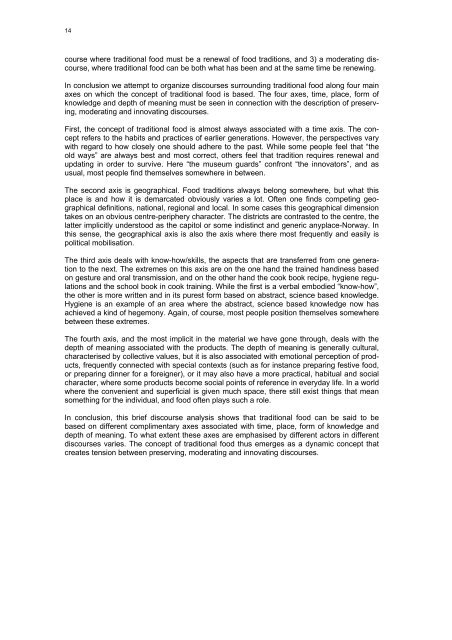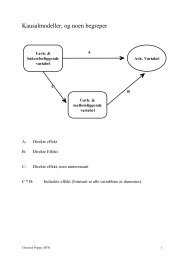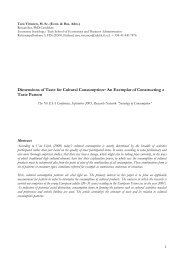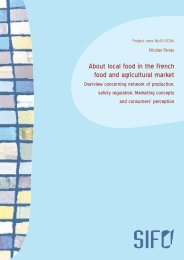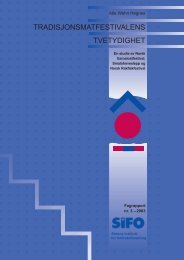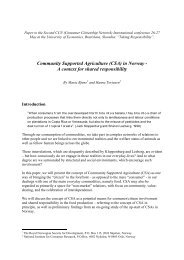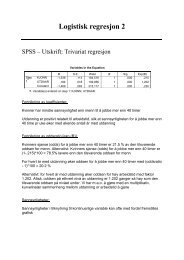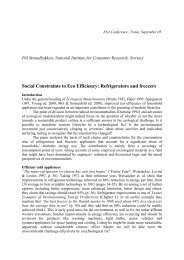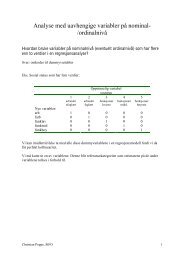Create successful ePaper yourself
Turn your PDF publications into a flip-book with our unique Google optimized e-Paper software.
14<br />
course where traditional food must be a renewal of food traditions, and 3) a moderating discourse,<br />
where traditional food can be both what has been and at the same time be renewing.<br />
In conclusion we attempt to organize discourses surrounding traditional food along four main<br />
axes on which the concept of traditional food is based. The four axes, time, place, form of<br />
knowledge and depth of meaning must be seen in connection with the description of preserving,<br />
moderating and innovating discourses.<br />
First, the concept of traditional food is almost always associated with a time axis. The concept<br />
refers to the habits and practices of earlier generations. However, the perspectives vary<br />
with regard to how closely one should adhere to the past. While some people feel that “the<br />
old ways” are always best and most correct, others feel that tradition requires renewal and<br />
updating in order to survive. Here “the museum guards” confront “the innovators”, and as<br />
usual, most people find themselves somewhere in between.<br />
The second axis is geographical. Food traditions always belong somewhere, but what this<br />
place is and how it is demarcated obviously varies a lot. Often one finds competing geographical<br />
definitions, national, regional and local. In some cases this geographical dimension<br />
takes on an obvious centre-periphery character. The districts are contrasted to the centre, the<br />
latter implicitly understood as the capitol or some indistinct and generic anyplace-Norway. In<br />
this sense, the geographical axis is also the axis where there most frequently and easily is<br />
political mobilisation.<br />
The third axis deals with know-how/skills, the aspects that are transferred from one generation<br />
to the next. The extremes on this axis are on the one hand the trained handiness based<br />
on gesture and oral transmission, and on the other hand the cook book recipe, hygiene regulations<br />
and the school book in cook training. While the first is a verbal embodied “know-how”,<br />
the other is more written and in its purest form based on abstract, science based knowledge.<br />
Hygiene is an example of an area where the abstract, science based knowledge now has<br />
achieved a kind of hegemony. Again, of course, most people position themselves somewhere<br />
between these extremes.<br />
The fourth axis, and the most implicit in the material we have gone through, deals with the<br />
depth of meaning associated with the products. The depth of meaning is generally cultural,<br />
characterised by collective values, but it is also associated with emotional perception of products,<br />
frequently connected with special contexts (such as for instance preparing festive food,<br />
or preparing dinner for a foreigner), or it may also have a more practical, habitual and social<br />
character, where some products become social points of reference in everyday life. In a world<br />
where the convenient and superficial is given much space, there still exist things that mean<br />
something for the individual, and food often plays such a role.<br />
In conclusion, this brief discourse analysis shows that traditional food can be said to be<br />
based on different complimentary axes associated with time, place, form of knowledge and<br />
depth of meaning. To what extent these axes are emphasised by different actors in different<br />
discourses varies. The concept of traditional food thus emerges as a dynamic concept that<br />
creates tension between preserving, moderating and innovating discourses.


